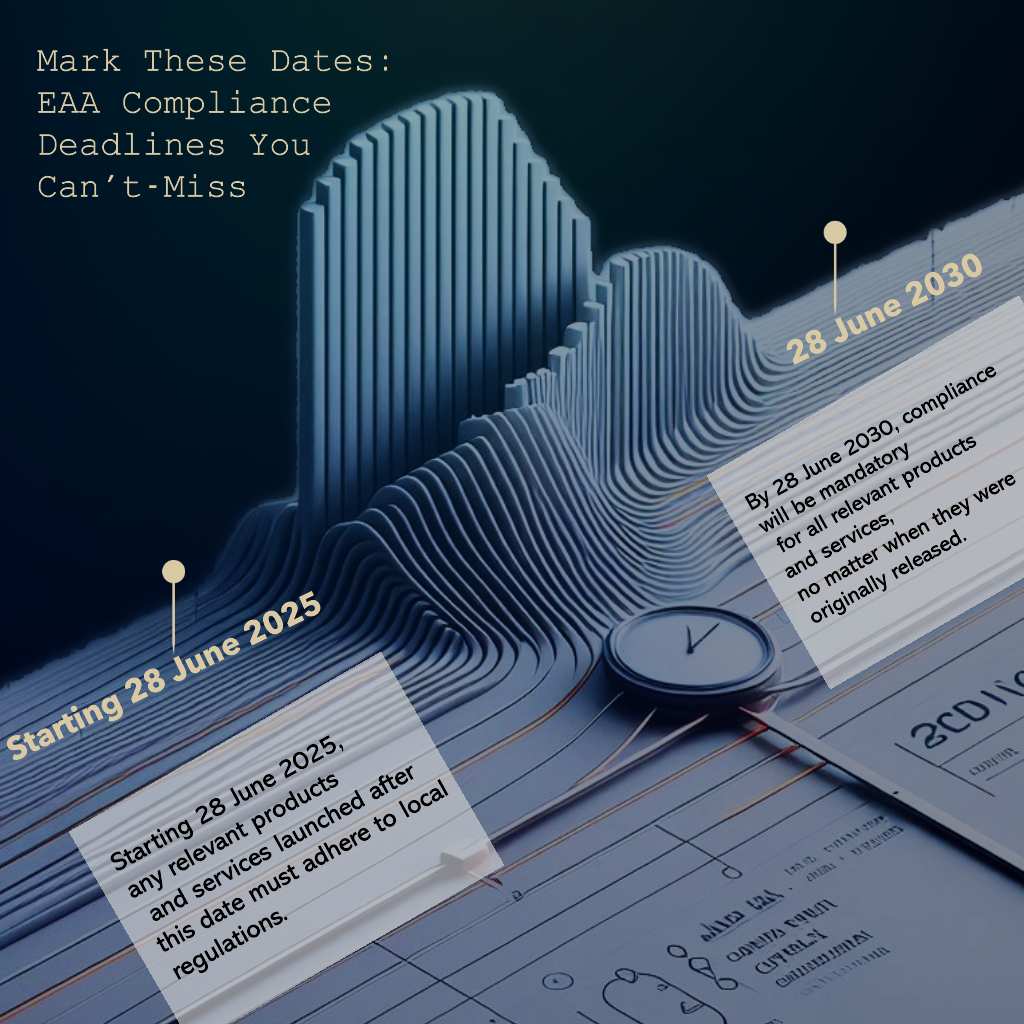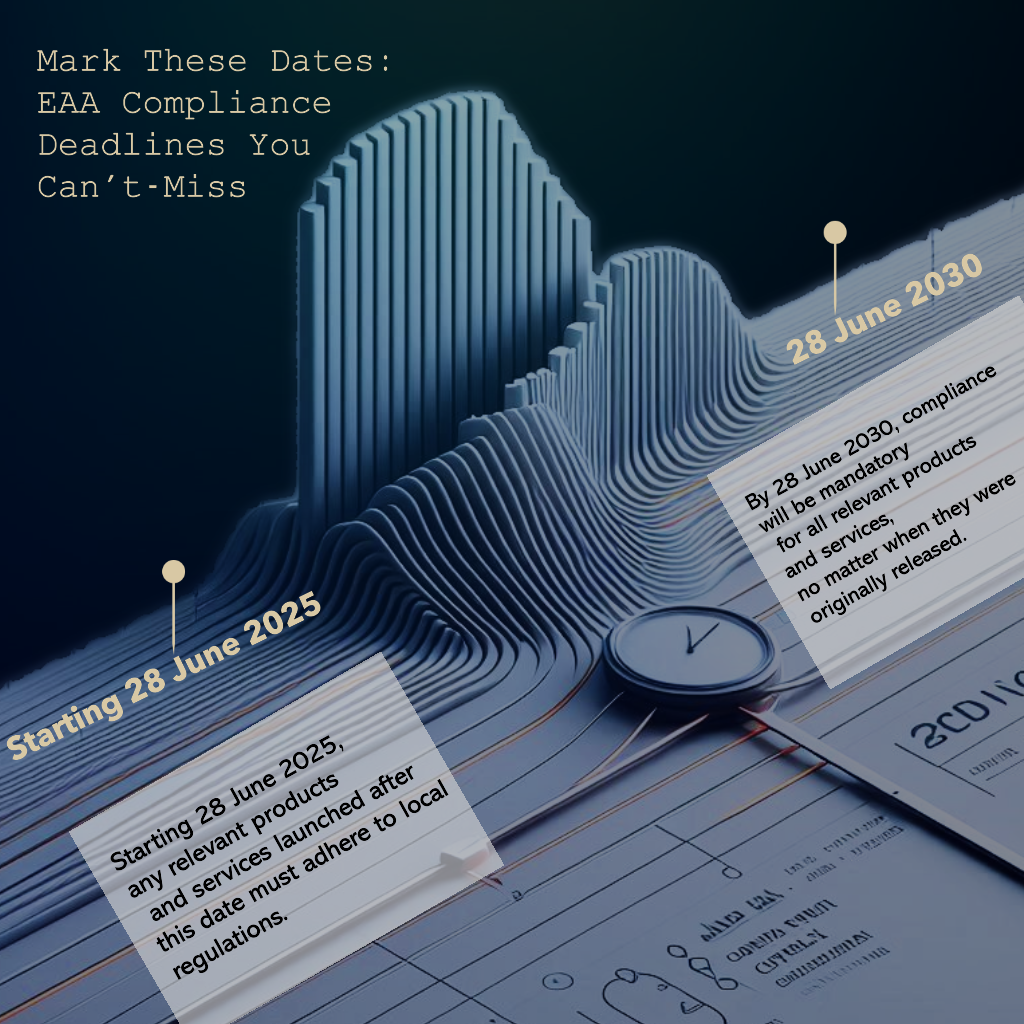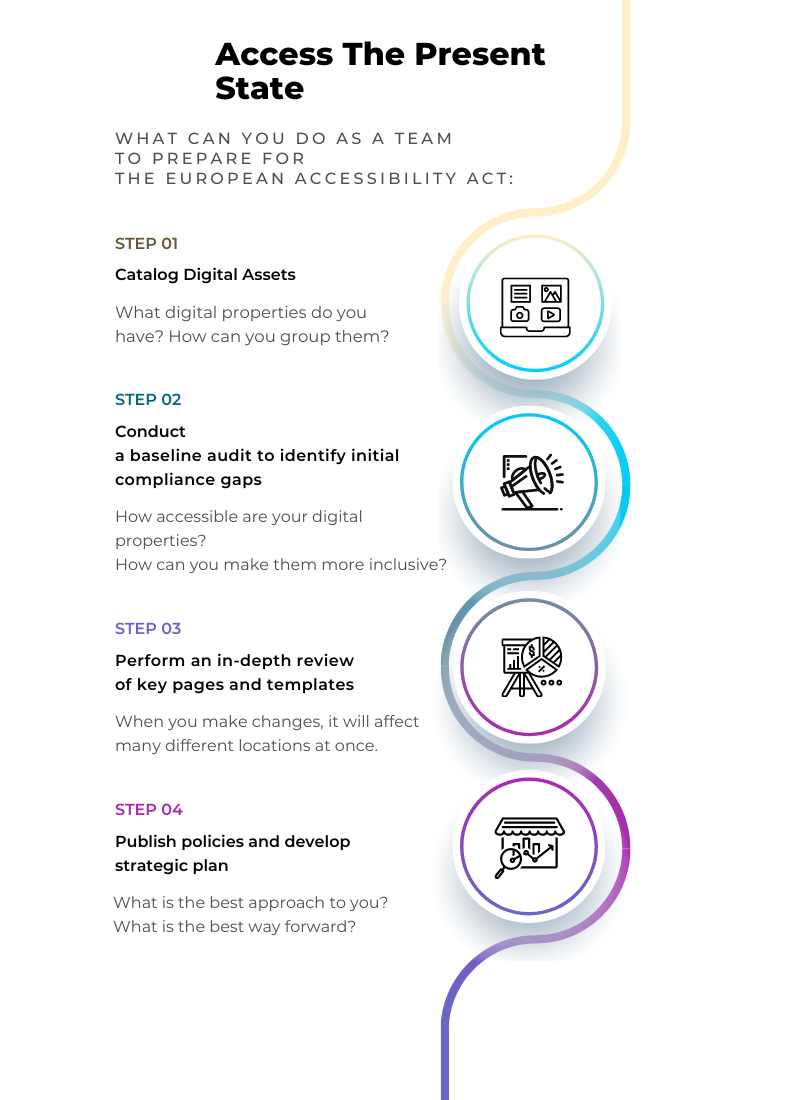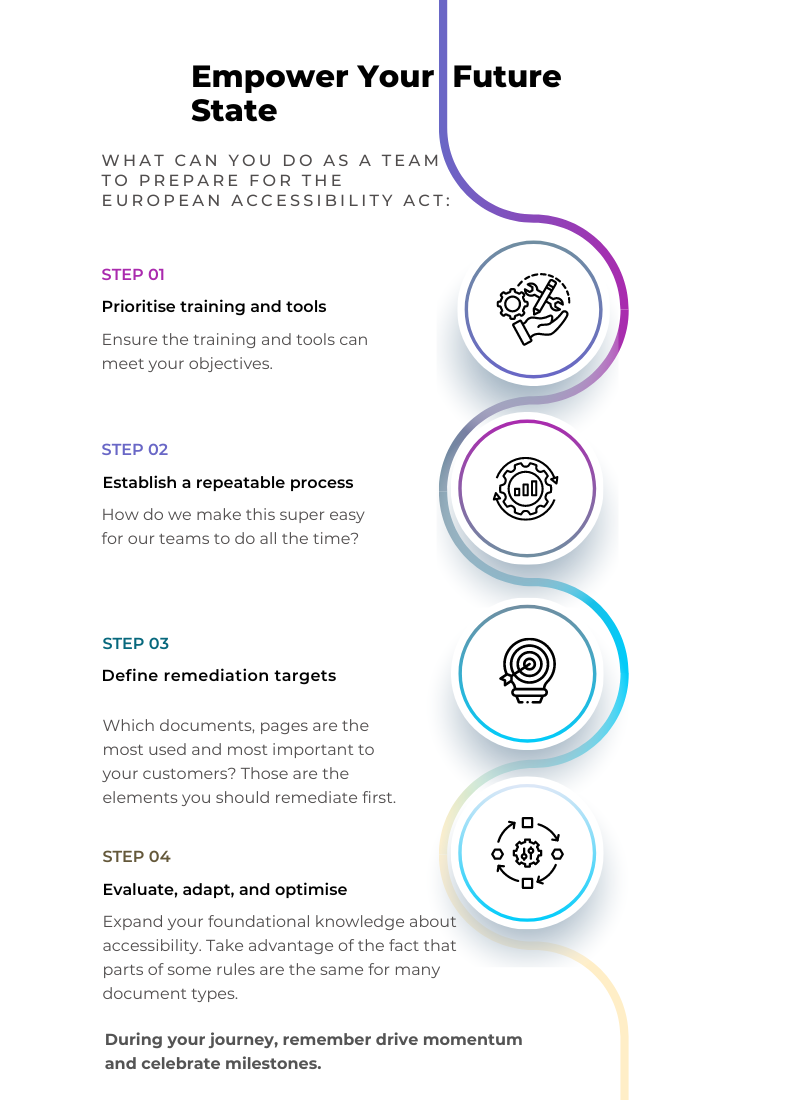Unlocking the European Accessibility Act: How Tech Teams Can Lead the Way
 Joanna
JoannaTable of contents
- Overview of the European Accessibility Act
- Why the EAA Matters to You
- Global Reach and Compliance Obligations Under the EAA
- Mark These Dates: Compliance Deadlines You Can't-Miss
- What Products and Services Does the EAA Cover?
- How to Prepare for the EAA
- Consequences of Non-Compliance
- Companies That Grew Their Businesses Through Accessibility
- Turning Compliance into Competitive Advantage
- Glossary:

The European Accessibility Act (EAA) is a new directive that will reshape the landscape of information technology accessibility across the EU and beyond. This article explains its impact, why it matters, and how businesses can prepare.
Overview of the European Accessibility Act
The European Accessibility Act (EAA), effective from June 2025, is a pivotal piece of legislation to enhance accessibility. EAA states that everyone deserves equal access to digital services and technology, regardless of their abilities or disabilities. The EAA embodies the belief that:
A truly inclusive society is one where all individuals, regardless of their physical or cognitive abilities, can fully participate in and benefit from the digital world.
This goes beyond mere compliance or profit motives. The EAA recognises that as we all age and potentially face temporary or permanent disabilities, creating accessible products and services is essentially designing for our future selves. It's about ensuring no one is left behind in our increasingly digital societies.
Its scope extends beyond the public sector, covering a wide range of goods and services offered by public and private sector organisations.
EAA targets economic operators and service providers; if you sell a product or service in the EU, the EAA impacts you even if you are not EU based company.
The EAA is expected to have a more significant impact than previous regulations like the GDPR, particularly in scale and compliance. Its purpose is to make society equal and to give everybody space to use their potential and participate because digital services and Technology are an integrated part of our daily lives.
As developers, UI/UX experts, designers, technical writers, and product owners, our role in shaping accessible digital experiences is crucial. New regulations require multi-teams cooperation. To make this collaboration possible, it is vital to understand what accessibility is and how to think about it. Start talking with people who work in different departments from creation to development and have impact on the final look of the project/product/website/application. While assembling your team, go deeper to understand the current status. Ask yourself: “What digital properties do I have? How accessible are they? Have I considered how these changes will impact my workflow as a developer?”
Engage with your team, stay informed about the latest regulations, and prioritise accessibility from the beginning of any project. All these activities will allow you to start looking at remediating your technical debt and ensure accessibility is integrated at every stage of the product development lifecycle.
Why the EAA Matters to You
The EAA is transformative in relation to WCAG 2.1 because it demands that our content and the tools we use to deliver it be fully accessible. This goes beyond traditional web guidelines, introducing strict requirements that may include features like dark mode, custom themes, colour adjustments, and reduced motion settings. These rules apply to the product or service and extend to all related documentation and support materials, which must be digitally accessible and contain specific set of information. Additionally, there are stringent standards for biometrics, voice and video communications, and real-time text.
A crucial point about the EAA is its clear stance against using overlays and widgets as compliance workaround. Companies must ensure their websites natively meet accessibility standards without depending on these tools. Often, such tools create a misleading impression of compliance, masking underlying issues rather than addressing them, which can prevent screen readers from functioning correctly and leave accessibility challenges unresolved.
Global Reach and Compliance Obligations Under the EAA
The EAA affects any business that trades within the EU, regardless of where it is based. This includes businesses headquartered outside the EU that sell goods or services within the EEA (European Economic Area) market. Compliance is mandatory for businesses with at least ten staff and an annual turnover exceeding €2 million.
Notably, the EAA will may also directly impact UK businesses, even post-Brexit, as it applies to all organisations supplying to both public and private sector entities within the EU. It is worth keeping in mind that every EU member state may define the additional requirements and define their own surveillance, enforcement and their own penalties (e.g., Ireland’s max penalty is 60k euro fine + 18 mos. Imprisonment, Duch implementation: max. fine 103k euro per violation (!)).
Sources: [1].
Penalties:
Effective, proportionate and dissuasive
Effective remedial action
In relation to the extent of the non-compliance:
Seriousness
Number of non-complying products or services
Number of people affected
Enforcement:
Two general obligations for Member States:
Possibility for consumer complaints
Enforcement by national supervisors
Exceptions:
Grace period - more info in the EAA documentation (It is essential to know that the grace period varies greatly depending on the specific case)
Fundamental alteration and disproportionate burden - more info in the EAA documentation
General exceptions:
B2B: the EAA only applies to consumer interactions/ transactions (art. 2 EAA)
Micro enterprises: enterprises which employ fewer than ten persons and with an annual turnover lower than EUR 2 million are exempted from compliance with the EAA (art. 4.5 EAA)
Other: exceptions for pre-recorded time-based media, archives, and certain third-party content (art. 2.4 EAA)
Sources: [5] and [4].
Mark These Dates: Compliance Deadlines You Can't-Miss

Infographic generated by Dall-E, updated with Figma.
There are two critical deadlines:
Starting 28 June 2025, any relevant products and services launched after this date must adhere to local regulations.
By 28 June 2030, compliance will be mandatory for all relevant products and services, no matter when they were originally released.
What Products and Services Does the EAA Cover?
The EAA covers a broad spectrum of products and services, including but not limited to:
Computers and operating systems
Smartphones
TV equipment and broadcasting services
Transportation services (air, bus, rail, waterborne)
Banking services
E-commerce
ATMs, ticketing, and check-in machines
Each product and service is governed by specific standards that must be met to operate in the EU legally.
Businesses need to familiarise themselves with these standards to ensure compliance.
How to Prepare for the EAA
With just less than a year until the EAA comes into effect, businesses should take immediate steps to prepare.
EAA compliance for tech teams


Infographics created based on sources: [1] and [2].
What can you do as a company
Key Takeaways from Deque Systems (from Webinar):
Consult your legal team to ensure the EAA is on their radar.
Determine how the EAA applies to your products and services.
Conduct accessibility audits of your current offerings.
Develop a plan to address any compliance gaps before the June 2025 deadline.
Familiarise yourself with the legislation (Annex 1) and EU standards such as EN 301 549.
By taking proactive measures, businesses can avoid expensive and disruptive effects of non-compliance.
Consequences of Non-Compliance
Failure to comply with the EAA can lead to significant penalties, including:
Fines:
Regulatory authorities in each EU member state will impose fines based on the severity of the violation and the size of the business.
Legal Action:
Non-compliant businesses may face lawsuits from individuals or advocacy groups.
Reputational Damage:
Negative publicity and a damaged brand image are likely consequences of non-compliance.
Loss of Customers:
Inaccessible products alienate potential customers, whereas prioritising accessibility broadens the customer base.
Procurement Exclusion:
EAA compliance will be increasingly required in public and private sector procurement processes, and non-compliant businesses may be excluded.
Companies That Grew Their Businesses Through Accessibility
A frequent objection to accessibility is, that calculating its return on investment is challenging. However, there are many examples demonstrating that investing in accessibility pays off. Here, you can read about three with very strong data behind every case. It can drive business growth by expanding market reach and improving SEO performance. These factors, in turn, affect revenue growth if we look at the whole thing from a bigger-picture perspective.
I chose examples highlighting how prioritising accessibility can lead to improved customer experience and substantial business growth. For more details, you can explore the full article on Scope's website here.
The following three case studies are particularly impactful:
Tesco: By making their online grocery service accessible, (at one point, Tesco realised that sighted users also found the new interface - initially designed for visually impaired individuals, easier to navigate. This insight led the company to integrate accessibility features across all its online services.) Tesco saw a significant increase in online sales, going from £52 million in 2000 to £235 million in 2001. This demonstrates the tangible business benefits of accessibility.
Legal & General: This financial services provider improved their website’s accessibility, leading to a 50% increase in organic search traffic and substantial cost savings in site maintenance.
The NHS: A digital overhaul focusing on accessibility doubled their daily users and dramatically improved user experience, showcasing the societal and business value of accessible digital services.
Turning Compliance into Competitive Advantage
Compliance with the EAA goes beyond avoiding penalties; it enhances customer experience and promotes inclusivity. In Great Britain, the number of disabled adults who were recent internet users in 2020 reached almost 11 million, or 81% of disabled adults, up from just over 10 million (78% of disabled adults) in 2019. (from Office for National Statistics).
Digital inclusivity in products and services benefits everyone, enabling broader participation in a digital society. Multimodality, or offering multiple formats to accommodate diverse needs, will be a key focus of the EAA, driving innovation and industry-wide progress.
The EAA is an opportunity to get it right the first time and efficiently scale accessibility across markets. Implementing EAA-compliant solutions may present challenges, particularly for businesses dealing with legacy code and outdated infrastructure (more about Technical debt in the Glossary or links in the Sources). However, the right strategy and planning can help overcome them.
Equal access and inclusive design can build trust and excitement among businesses and consumers. This perspective shifts the focus from viewing the act as a regulatory burden to seeing it as an opportunity for innovation, market expansion, and the creation of products that genuinely serve all users.
Companies that embrace this mindset are more likely to approach EAA compliance to enhance their products and services rather than just fulfil a legal requirement. This positive outlook can inspire enthusiasm for accessibility, drive creative solutions, and potentially unlock new market opportunities.
Additionally, by highlighting the universal advantages of accessible design EAA encourages a shared sense of purpose and responsibility among businesses and consumers. This approach can foster loyalty not just to specific brands but to the broader goal of an inclusive digital society.
I personally believe that the European Accessibility Act is not a threat or burden but a catalyst for creating a more inclusive, innovative, and forward-looking digital world.
I’m curious to know how you plan to prepare for the EAA or what challenges you anticipate?
Thank you for your time!
Glossary:
What is EN 301 549?
Harmonised European Standard
Applicable to all ICT products & services (not just web: electronic devices, non-web software, documents, etc.)
Developed by ETSI, CEN & CENELEC (not W3C)
Increasingly used outside Europe: Australia, Canada, Japan, India & Kenya
Requirements of EN 301 549:
Builds on top of WCAG 2.1 Level A + AA (Expect an update to WCAG 2.2 sometime in 2025/ 2026)
Many requirements go beyond WCAG 2.1:
User preferences & settings
Documentation & support services
Authoring tools, such as CMS & site’s comment section
Biometrics, voice & video communication, real-time text
More information: ETSI - Accessibility requirements for ICT products and services or DEQUE - European standard for digital accessibility
What is WCAG 2.1?
Web Content Accessibility Guidelines (WCAG) 2.1.
Set of globally adopted standards.
The guidelines aim to make websites, apps, electronic documents, and other digital assets accessible to people with a broad range of disabilities, including sensory, intellectual, learning and physical disabilities.
More information: W3C - What’s New in WCAG 2.1
What is technical debt?
The most useful way to think about tech debt is that it represents work you’ll have to do in the future to refactor or update code that you’re using or releasing to production today. (LeadDev - 6 steps to addressing legacy enterprise code Tech).
What are some categories of Technical Debt?
Coding Debt - Encompasses subpar coding practices, such as redundant code, overly lengthy methods, and unnecessary complexity. For instance, a method with elevated cyclomatic complexity suggests challenges in testing and maintaining the code.
Design Debt - Design debt stems from less-than-ideal design choices, such as poorly defined module boundaries, excessive coupling, and insufficient modularity. These issues can hinder the system’s scalability and adaptability.
Documentation Debt - Insufficient or outdated documentation can confuse and prolong the onboarding process for new team members. Keeping documentation current is essential for effective knowledge transfer and code sustainability.
Testing Debt - A lack of comprehensive or high-quality tests can impede the ability to verify code reliability and refactor confidently. Significant test debt often leads to uncertainty when making changes to the codebase.
More information: Legacy Code Refactoring
Sources:
Deque Systems, Inc. Webinar: Countdown to enforcement 2025: Navigating the European Accessibility Act (On 04.10.2024, the entire recording was available for free after filling out the registration form.)
AbilityNet, TechShare Pro 23: How will the European Accessibility Act change the global accessibility landscape
Digita11y Accessible: Practical Guide for UX Designers on Ensuring Accessibility
European Commission: European Accessibility Act: Q&A
European Commission: European Accessibility Act
University of Greenwich: Creating accessible documents
Office for National Statistics: Internet users, UK: 2020
Subscribe to my newsletter
Read articles from Joanna directly inside your inbox. Subscribe to the newsletter, and don't miss out.
Written by
